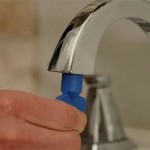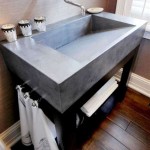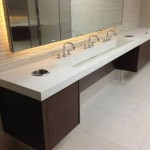Elevate Your Bathroom Design: A Comprehensive Guide to Bathroom Wall Backsplash Ideas
A bathroom backsplash transcends mere functionality; it serves as a pivotal design element capable of transforming the ambiance of the space. By protecting walls from water damage and offering an opportunity for creative expression, the backsplash is an integral part of bathroom design. Selecting the appropriate backsplash involves careful consideration of materials, styles, and installation techniques. This article offers a detailed exploration of various backsplash ideas, targeting those seeking to enhance both the aesthetic appeal and practical utility of their bathrooms.
Understanding the Purpose of a Bathroom Backsplash
The primary function of a bathroom backsplash is to safeguard walls against water damage. Constant exposure to moisture from sinks, showers, and tubs can lead to mold growth, paint peeling, and structural deterioration. A well-chosen backsplash creates a water-resistant barrier, preventing these issues and prolonging the lifespan of the wall. Beyond protection, the backsplash contributes significantly to the overall aesthetic of the bathroom. It provides a canvas for introducing color, texture, and pattern, thereby personalizing the space and reflecting individual style preferences.
The location of the backsplash is also a critical factor. Commonly installed behind sinks and vanities, backsplashes can extend to the countertop, partially up the wall, or even reach the ceiling for a dramatic design statement. In shower areas, backsplashes can encompass entire walls, offering comprehensive protection against moisture. Choosing the appropriate height and coverage depends on the bathroom's layout, usage patterns, and desired visual impact.
Exploring Material Options for Bathroom Backsplashes
The selection of backsplash material is paramount to achieving the desired combination of durability, aesthetics, and ease of maintenance. Numerous options are available, each with its unique set of advantages and disadvantages. Here's a detailed overview of popular choices:
Tile: Tile remains a consistently popular choice due to its versatility, durability, and water resistance. Available in a wide array of materials, shapes, sizes, and colors, tile offers endless design possibilities. Ceramic and porcelain tiles are particularly suitable for bathrooms due to their non-porous nature and resistance to stains. Glass tiles provide a sleek, modern look and reflect light, making the bathroom appear brighter. Natural stone tiles, such as marble and granite, exude luxury and sophistication, but require regular sealing to prevent staining. Subway tile, a classic rectangular tile, offers a timeless appeal and can be arranged in various patterns, including horizontal, vertical, and herringbone.
Glass: Glass backsplashes offer a contemporary aesthetic and can be customized in various colors, shapes, and finishes. They are non-porous, making them resistant to water damage and easy to clean. Glass tiles, mosaics, and even large glass panels can be used to create a seamless and visually stunning backsplash.
Stone: Natural stone backsplashes, such as marble, granite, and slate, bring a touch of elegance and sophistication to the bathroom. Each stone slab is unique, offering natural variations in color and pattern. However, stone requires regular sealing to protect it from stains and water damage.
Metal: Metal backsplashes, including stainless steel, copper, and brass, offer a modern and industrial aesthetic. They are durable, easy to clean, and can add a touch of glamour to the bathroom. Metal tiles, sheets, and even textured panels can be used to create a unique and eye-catching backsplash.
Wallpaper: While less conventional, wallpaper can be used as a backsplash in low-moisture areas, such as behind a powder room sink. Choose a vinyl or moisture-resistant wallpaper specifically designed for bathroom use. Wallpaper offers a wide range of patterns, colors, and textures, allowing for creative expression.
Beadboard: Beadboard, a wooden paneling with vertical grooves, offers a traditional and charming aesthetic. It can be painted to match any color scheme and adds texture to the bathroom. However, beadboard is susceptible to water damage and requires proper sealing and maintenance.
Exploring Styles and Design Ideas
The style of the bathroom backsplash should complement the overall design of the space. Consider the existing fixtures, color scheme, and architectural style when selecting a backsplash. Several design ideas can transform the bathroom into a visually appealing and functional space.
Classic Subway Tile: Subway tile is a timeless and versatile choice that complements various bathroom styles. Arrange the tiles horizontally for a traditional look, vertically for a modern twist, or in a herringbone pattern for added visual interest. Choose a contrasting grout color to highlight the tile pattern.
Mosaic Tile: Mosaic tiles, consisting of small pieces of glass, ceramic, or stone, offer endless design possibilities. Create intricate patterns, geometric designs, or even custom murals. Mosaic tiles can add texture, color, and visual interest to the backsplash.
Geometric Patterns: Geometric patterns, such as hexagons, triangles, and chevrons, are a modern and stylish choice for bathroom backsplashes. These patterns can add visual interest and a contemporary flair to the space.
Statement Walls: For a dramatic and bold statement, consider extending the backsplash to cover the entire wall behind the sink or shower. This can be achieved with large-format tiles, stone slabs, or even a custom-designed mural. A statement wall can create a focal point and transform the bathroom into a luxurious retreat.
Accent Tiles: Incorporate accent tiles into the backsplash to add pops of color, texture, and visual interest. Use decorative tiles, glass tiles, or even metal tiles to create a unique and personalized design.
Mirror Panels: Integrating mirror panels into the backsplash can create the illusion of more space and enhance the brightness of the bathroom. Mirror panels reflect light, making the bathroom appear larger and more inviting.
Textured Tiles: Textured tiles, such as wave tiles, rippled tiles, or even 3D tiles, can add depth and visual interest to the backsplash. These tiles create a tactile experience and can transform the bathroom into a spa-like retreat.
Color Palette Considerations: The color of the backsplash should complement the existing color scheme of the bathroom. Consider using neutral colors, such as white, gray, or beige, for a timeless and versatile look. Incorporate pops of color with accent tiles or accessories. For a bold and dramatic statement, use contrasting colors or vibrant hues.
Grout Selection: Grout plays a crucial role in the overall aesthetic of the backsplash. Choose a grout color that complements the tile color and enhances the design. Consider using epoxy grout, which is more resistant to stains and mildew than traditional cement grout.
Installation and Maintenance
Proper installation is essential for ensuring the longevity and performance of the bathroom backsplash. While DIY installation is possible for some, professional installation is recommended for intricate designs or complex materials. Here are some essential considerations for installation and maintenance:
Surface Preparation: Ensure the wall surface is clean, dry, and free of any debris. Repair any cracks or imperfections before installing the backsplash. Apply a waterproof membrane to protect the wall from moisture.
Tile Layout: Plan the tile layout carefully to ensure a balanced and aesthetically pleasing design. Use spacers to maintain consistent grout lines.
Cutting Tiles: Use a tile cutter or wet saw to cut tiles to the desired size and shape. Wear safety glasses and gloves to protect yourself from injury.
Applying Adhesive: Apply tile adhesive evenly to the wall surface using a notched trowel. Press the tiles firmly into the adhesive, ensuring proper alignment.
Grouting: Once the adhesive has dried, apply grout to fill the spaces between the tiles. Use a grout float to spread the grout evenly and remove excess grout with a sponge.
Sealing: Seal the grout lines to protect them from stains and mildew. Apply a sealant specifically designed for bathroom use.
Cleaning and Maintenance: Clean the backsplash regularly with a mild soap and water solution. Avoid using abrasive cleaners or harsh chemicals, which can damage the tile and grout. Wipe up any spills immediately to prevent stains.
Regular Inspection: Inspect the backsplash regularly for any signs of cracks, leaks, or damage. Address any issues promptly to prevent further deterioration.
By carefully considering these factors, individuals can select the appropriate backsplash material, design, and installation techniques to create a bathroom that is both aesthetically pleasing and functionally sound. The transformative power of a well-chosen backsplash is undeniable, turning an ordinary bathroom into a stylish and inviting sanctuary.

62 Bathroom Backsplash Ideas For A Stylish Makeover Remodel Tile Vanity

20 Amazing Bathroom Backsplash Ideas For Your Designs Foyr

47 Modern Bathroom Backsplash Sleek Plain Tile Designs

15 Bathroom Backsplash Ideas

23 Bathroom Backsplash Ideas Sebring Design Build Inspiration Decor Remodel Designs Interior

Blue Glass Large Herringbone Mosaic Backsplash Tile

20 Subway Tile Design Ideas For Bathrooms

20 Amazing Bathroom Backsplash Ideas For Your Designs Foyr

27 Herringbone Tile Bathroom Backsplash Chic Fishbone

Backsplash Tile For Bathroom Sinks Vanities The
Related Posts







